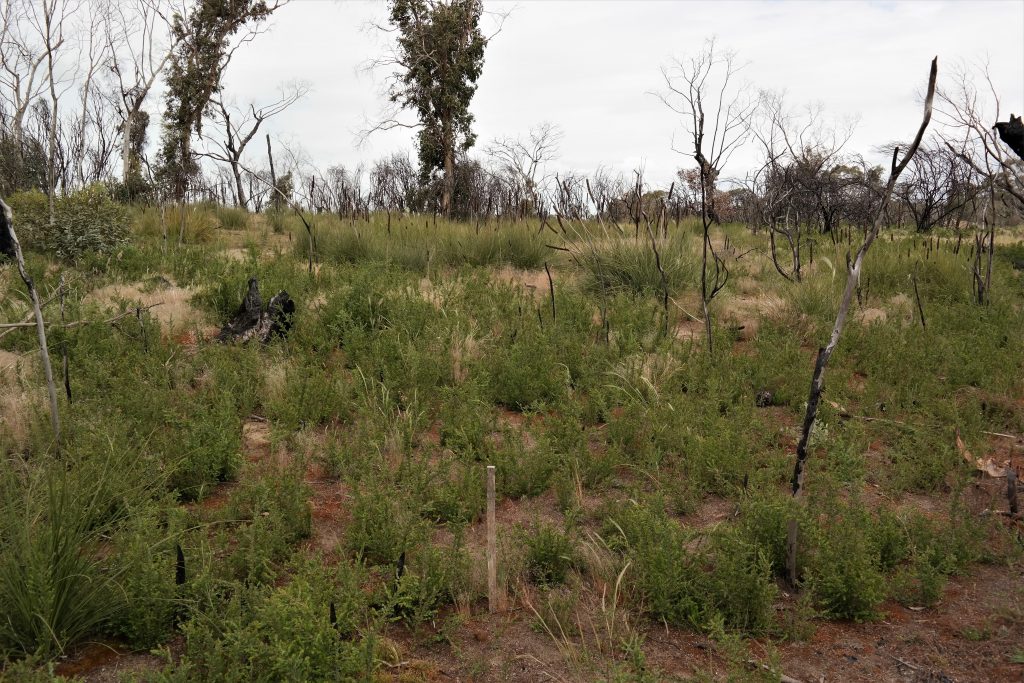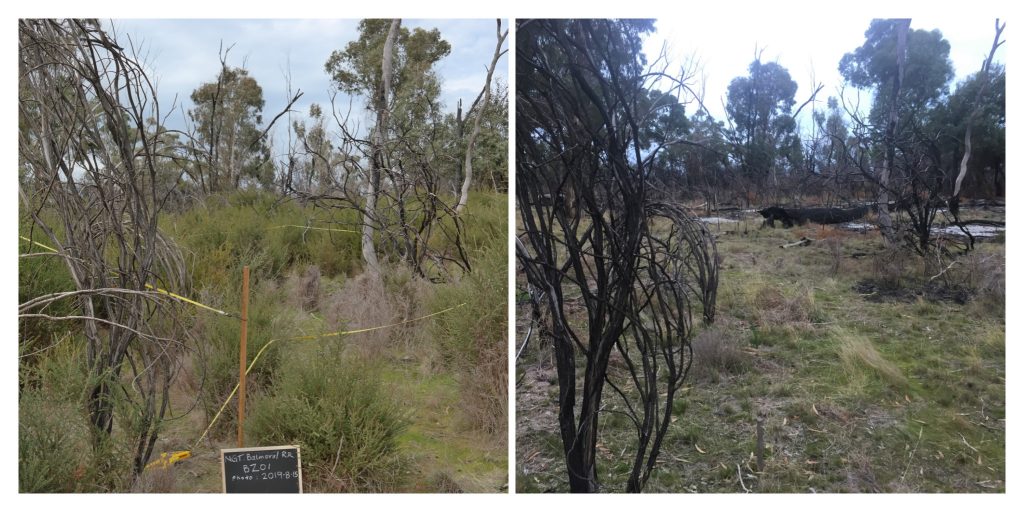A prickly character – controlling Hedge Wattle at Balmoral Recreation Reserve
Since Winter 2019, NGT has been working with the CFA and the Balmoral Recreation Reserve Committee of Management (CoM) to control Hedge Wattle (Acacia paradoxa) within plains grassy woodland of the Dundas Tablelands bioregion at the reserve in south-west Victoria. You can read a bit about the ecology of the woodland and the early phase of the control program here.
While Hedge Wattle can play an important role in native vegetation communities such as this grassy woodland, the extensive plantings of non indigenous forms of the species and a disturbance history at the site favouring the expansion and dominance of Hedge Wattle has started to impact on the health of the grassy woodland system. The aim of the program is to control the Hedge Wattle to a maximum of 5% cover across the woodland – a density that reflects more closely what small and medium shrubs would contribute to a remnant grassy woodland community.
A bushfire that burnt the majority of the Hedge Wattle and western section of woodland at the reserve in December 2017 has in some respects brought about a new opportunity in controlling the species – the fire was very intense in most of the burn area, killing the dense and mature Hedge Wattle stands, as well as promoting prolific germination (and depletion) of soil-stored seed. While this also meant the establishment of emerging seedlings, there is now a window of opportunity to eliminate these plants before they mature and when the size and fuel load of the plants is much lower than what it has been.
So far the control works have focussed on mechanically removing dense thickets of older, mature Hedge Wattle in degraded patches (undertaken by local contractors), as well as using more targeted control. This has included hand weeding of small, immature plants, and cut and paste (herbicide dabbing) of a less dense cohort of two to five year old shrubs to prevent flowering and further seed set. One of the results of the cut and pasting has been a lot of dead shrubs lying around the site.

Left: The piercing thorns of the Hedge Wattle requires a double layer of gloves! Middle: NGT crew cutting and dabbing the medium sized cohort of Hedge Wattle. Right: NGT has also been trialling the use of different techniques to efficiently control germinants such as with a hand held flame wand.
In order to remove this additional nutrient and fuel load, as well as to clean up a bit, NGT met with members of the North Balmoral CFA brigade to pile and burn the cut material. We had a nice cool, cloudy and still day to do the burning off – and even though we kept the piles pretty small, it was very toasty! You can see what we mean in the short video below.
The Hedge Wattle is given the nickname “Kerosene Bush” because of it’s ferocity once it starts to combust in a fire – it was estimated that the height of the 2017 fire where dense Hedge Wattle burnt reached twice that of the eucalypt canopy. While fire is also potentially a very efficient tool in killing and controlling Hedge Wattle, it is a bit of a balancing act in getting conditions right for a fire hot enough to carry through the living vegetation, but one that remains controllable. One day it seems no matter how hard you try, a fire will simply not get going in the green vegetation, and the next day a slight change in weather and wind means a completely different picture, with the intensity of a fire very hard to contain.

The dense juvenile Hedge Wattle which germinated following a high intensity fire in December 2017. Without control efforts, these plants will quickly crowd and out-compete native ground cover and significantly change the ecology of the grassy woodland community. Note the regenerating Eucalypts and the burnt dead stems of the previous Hedge Wattle cohort.
NGT has also recently conducted some control trials to look at the efficiency of different techniques including some very small trial burns in the dense patches of the post 2017 Hedge Wattle in trying to understand a bit more about the behaviour of the fuel in different conditions. Now NGT is working with stakeholders including the local CFA brigade to plan for the potential use of fire in a very targeted manner – at a small and patchy scale based on the pattern of infestation and the conditions of the local vegetation and terrain. A mosaic of small burns may finally give us the upper hand where other more targeted and time consuming control techniques would not be feasible in such a large and dense infestation. Hopefully with fire as an additional management tool the whole infestation will be effectively treated, and we will see a much healthier, restored woodland community in the next few years!

A comparison of one of the Hedge Wattle treatment sites (left) in August 2019 before treatment commenced and (right) in May 2020 following the cut and paste of the Hedge Wattles and burning of the off-cuts.
This program has been funded by the CFA, and supported by The Balmoral Recreation Reserve CoM, Andrew Govanstone (Vegetation Management Officer) of CFA Hamilton, North Balmoral CFA brigade, and Dr. John Morgan of LaTrobe University.
